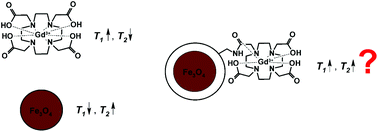Tuning the relaxation rates of dual-mode T1/T2 nanoparticle contrast agents: a study into the ideal system†
Abstract
Magnetic resonance imaging (MRI) is an excellent imaging modality. However the low sensitivity of the technique poses a challenge to achieving an accurate image of function at the molecular level. To overcome this, contrast agents are used; typically gadolinium based agents for T1 weighted imaging, or iron oxide based agents for T2 imaging. Traditionally, only one imaging mode is used per diagnosis although several physiological situations are known to interfere with the signal induced by the contrast agents in each individual imaging mode acquisition. Recently, the combination of both T1 and T2 imaging capabilities into a single platform has emerged as a tool to reduce uncertainties in MR image analysis. To date, contradicting reports on the effect on the contrast of the coupling of a T1 and T2 agent have hampered the application of these specialised probes. Herein, we present a systematic experimental study on a range of gadolinium-labelled magnetite nanoparticles envisioned to bring some light into the mechanism of interaction between T1 and T2 components, and advance towards the design of efficient (dual) T1 and T2 MRI probes. Unexpected behaviours observed in some of the constructs will be discussed. In this study, we demonstrate that the relaxivity of such multimodal probes can be rationally tuned to obtain unmatched potentials in MR imaging, exemplified by preparation of the magnetite-based nanoparticle with the highest T2 relaxivity described to date.


 Please wait while we load your content...
Please wait while we load your content...